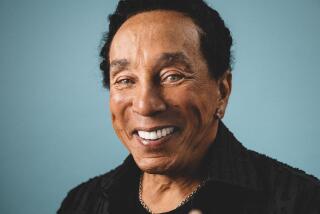Career Differences Noted in Smith, James Retrospectives
- Share via
Huey “Piano” Smith and Sonny James both enjoyed hits in the early days of rock ‘n’ roll, but their careers could scarcely have been more different. Smith only had two Top 20 R&B; hits, but his music was filled with personality. James had more than 40 Top 10 country hits, but few of them were memorable. Both artists are saluted by new retrospectives.
*** 1/2 Huey “Piano” Smith’s “This Is . . . Huey ‘Piano’ Smith,” Music Club. Songwriter-pianist Smith never enjoyed the chart success or high profile in the ‘50s of such other key New Orleans R&B; figures as Fats Domino and Lloyd Price, but he made some of the most colorful records of the era.
“Rockin’ Pneumonia and the Boogie Woogie Flu” and “Don’t You Just Know It” may have been his only Top 20 R&B; hits, but several of his other singles for Ace Records, including “Beatnik Blues” and “Pop-Eye,” had just as much playful personality and bounce.
Smith, in fact, just missed another hit when Johnny Vincent, who owned Ace Records, erased Smith’s vocal on a recording of “Sea Cruise” (which Smith wrote) and replaced it with a more animated one by Frankie Ford, Bill Dahl writes in the album’s liner notes. The Ford version made it to No. 14 on the pop charts in 1959.
Long before joining Ace Records, Smith gained a reputation around New Orleans as a session musician. That’s Smith playing piano on Smiley Lewis’ “I Hear You Knocking.”
Smith eventually wanted to make his own records, but he didn’t like singing, so he formed a vocal group, the Clowns, with Bobby Marchan handling lead vocals on “Rockin’ Pneumonia” (which was a Top 10 pop hit for Johnny Rivers in 1972).
Following the success of that single, Smith concentrated on novelties, many of them with illness gimmicks, such as “High Blood Pressure,” “Would You Believe It (I Have a Cold)” and even “Tu-Ber-Cu-Lucas and the Sinus Blues.”
The mystery after all these years is why he didn’t have more chart success, especially since his live shows were so amazing, author John Broven writes in “Walking to New Orleans,” a 1974 history of New Orleans R&B.;
“The combustive, energetic sound that Smith got in the recording studios must have been difficult to reproduce on stage,” Broven writes. “But he did just that and more. It was not unusual for Huey to stand up and play, just hitting the piano from time to time, while the Clowns were jumping around and singing leads at different parts.”
Too bad there isn’t an accompanying video.
** 1/2 Sonny James’ “The Classic Hits of Sonny James,” Razor & Tie. James shows just how fleeting fame can be. Between 1953 and 1977. the Arkansas native generated more than 40 Top 10 country hits, including a remarkable 16 No. 1 singles in a row at one point. James even enjoyed a bit of crossover success when “Young Love” went to No. 1 on the pop charts in the early days of rock.
Rather than pursue a pop-rock path, however, James devoted himself to country. His records, though, featured more of a pop-leaning, sing-along feel than the hard-core honky-tonk of, say, George Jones.
While pleasant, neither James’ singing nor the recordings have a particularly distinctive edge. More than a dozen of the No. 1 singles are contained in this package.
Also in the Stores: You can sample the softer side of such funk acts as Cameo, the Bar-Kays, Con Funk Shun and the Gap Band in Mercury Chronicles’ new “The Ballad Collection” series. . . . Del-Fi Records, the label started by Bob Keane in 1958 and best known as the home of Richie Valens, has released three volumes in a “Doo Wop” series,” each CD featuring tracks by such acts as the Pentagons, the Hep Cats, the Gallahads and Little Caesar & the Romantics.
Albums are rated on a scale of one star (poor), two stars (fair), three stars (good) and four stars (excellent).
More to Read
The biggest entertainment stories
Get our big stories about Hollywood, film, television, music, arts, culture and more right in your inbox as soon as they publish.
You may occasionally receive promotional content from the Los Angeles Times.








